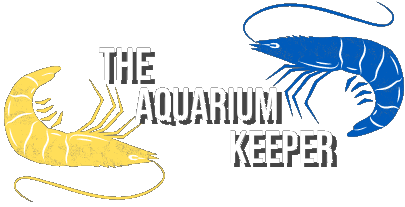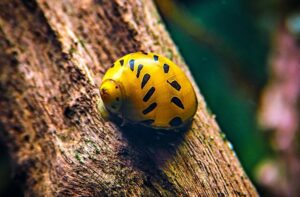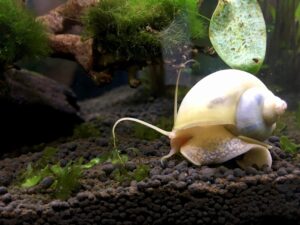
15 Column Feeding Aquarium Plants For Beginners

Writer at The Aquarium Keeper
There are a lot of different aquarium plants that you can choose from. Plants are essential in every tank, since they help clean the water, provide lots of hiding spaces for fish, and in general look amazing. Some plants are simply planted into the substrate, other species are essentially column feeding aquarium plants. This term is not widely used in this hobby, and it is perfectly normal if you do not know what it means. In this article, I will explain what column feeding aquarium plants are, and give a lot of plant suggestions, that every beginner could easily keep.
What Are Column Feeding Aquarium Plants?
In simple terms, column feeding aquarium plants are certain species, that do not need to be planted into the substrate to thrive. These types of plants don’t fully rely on their roots, and some of them even don’t have roots. Some column feeding aquarium plants can be attached to rocks, and driftwood and other species can literally thrive while floating in the water.
Nevertheless, column feeding aquarium plants still need some care to grow. Most of the species absorb nutrients through their leaves or stems, which means some sort of fertilizer needs to be added to the water. The combination of liquid fertilizer and some liquid CO2 is good enough for most column feeding plants.
Beginner Column Feeding Aquarium Plants
To begin this list, it is important to clarify what beginner column feeding aquarium plants are. The plant species mentioned below will be relatively hardy plants, that really do not need much care, aside from some liquid fertilizer, and occasional trimming for some species. Nevertheless, even though these plants are considered “beginner-friendly”, most of them do best in certain water conditions (temperature, pH), so be sure to follow the requirements.
There are countless column feeding aquarium plants, but the most popular ones are anubias, java fern, bucephalandra, and hornwort. They are often used in low-maintenance aquariums since they really don’t need much to survive.
Anubias
Firstly, probably the most popular column feeding aquarium plant is the anubias. It is widely known for being a versatile and hardy plant, that brings a dark green coloration to an aquarium.
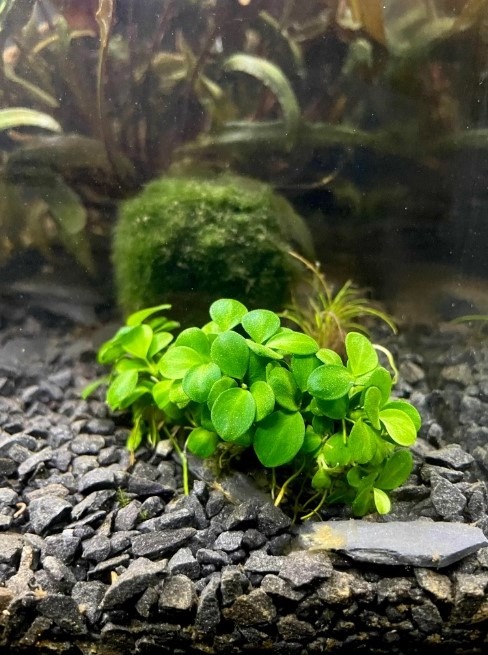
Anubias is a type of plant, that has a rhizome, which leaves and roots grow out of. Leaves are mainly responsible for nutrient absorption, while roots help anubias stay in one place. Here is more information about this plant:
- Scientific name: Anubias
- Water temperature: 23–28 °C (74–82 °F)
- Growth rate: Slow
- Lightning intensity: Low to medium
- pH: 5.5 – 8
- Need for CO2: Low
- Fertilizer: Liquid fertilizer, nutrient-rich substrate
- Planting: Can be planted on rocks, wood, and decorations, and can also be planted in substrate if the rhizome of the plant is not buried
- Tank position: Foreground/midground
- Maximum height: 7.5 in / 19 cm
- Care level: Easy
- Minimum tank size: 5 gallons
There are a lot of different anubias species available in the hobby. Some species have smaller leaves, like anubias nana petite, and others have different colorations, like anubias white, which has light green leaves instead of the classic dark green coloration. Anubias is a very versatile plant and does not need to be planted into the substrate. You can simply squeeze the plant between wedges and rocks, or glue it to a decoration using aquarium glue. It is a good beginner column feeding aquarium plant, since it can also live in low-tech or high-tech setups, and in general can tolerate a wide range of water parameters.
Bucephalandra
Another popular column feeding aquarium plant, that is very similar to anubias, is bucephalandra. It is a very beloved plant in the aquarium hobby, because of the dark green/brown coloration, which not a lot of aquarium plants have.

There are a lot of ways you can plant your bucephalandra in the tank. Some people attach it to decorations by squeezing it into gaps or using glue. Other fishkeepers choose to plant the plant roots into the substrate, but it is not a popular method of planting. Here is more information about this plant:
- Scientific name: Bucephalandra
- Water temperature: 22–29 °C (72–84 °F)
- Growth rate: Slow
- Lightning intensity: Low to medium
- pH: 5 – 8
- Need for CO2: Low
- Fertilizer: Liquid fertilizer, nutrient-rich substrate
- Planting: On decorations, driftwood, and rocks. Can be planted in the substrate if the rhizome is not buried
- Tank position: Foreground/midground
- Maximum height: 7 in / 18 cm
- Care level: Easy
- Minimum tank size: 5 gallons
Bucephalandra is another rhizome plant, that mainly uses leaves for nutrient absorption, and roots for attachment. Similar to anubias, there are a lot of different bucephalandra species to choose from, ranging from buces that have brown leaves, to other species, that can even have purple coloration! One discouraging thing about this plant is that these species are rather expensive compared to others. Bucephaladra is fairly new in this hobby, and the demand is higher than the supply. In good cases, you can get a piece of bucephalandra for about 5 – 7$.
Java Fern
Moving on, the java fern is another plant, that does not need to plant into the substrate to thrive. It is an excellent column feeding aquarium plant for beginners, due to its ability to handle different water conditions.

Java fern looks completely different compared to anubias and bucephalandra. These species have long pointy leaves, that are way thinner. Here is more information about java fern:
- Scientific name: Microsorum pteropus
- Water temperature: 20–28 °C (68–82 °F)
- Growth rate: Slow
- Lightning intensity: Low to medium
- pH: 6 – 7.5
- Need for CO2: Low
- Fertilizer: Liquid fertilizer, nutrient-rich substrate
- Planting: Can be attached to decorations, wood, and rocks, and also planted in the substrate, without burying the rhizome part of the plant
- Tank position: Foreground/midground
- Maximum height: 14 in / 35 cm
- Care level: Easy
- Minimum tank size: 5 gallons
Java fern can simply look like a big clump of leaves, and for that reason, it is one of the best plants for a shrimp tank. Java fern is also a good hiding space for smaller fish, which can get scared easily. This plant is widely used in all setups, including ones that are on the higher end. Because java fern has been this hobby for a very long time, it is really affordable and can be found in almost every aquarium store.
Java Moss
The first moss on this list is java moss. It is a very versatile plant, that can literally grow on anything in an aquarium. It is a biologically different plant from others on this list since it does not have roots, instead, java moss has rhizoids, which are only used for anchoring and keeping the plant in one place.

Java moss is a very good plant for tanks, that have small creatures like shrimp or nano fish. This particular plant can provide lots of hiding places, and the texture of the leaves is just amazing to look at. Here is more information about java moss:
- Scientific name: Taxiphyllum barbieri
- Water temperature: 21–25 °C (70–77 °F)
- Growth rate: Slow
- Lightning intensity: Low to medium
- pH: 5.5 – 8
- Need for CO2: Low
- Fertilizer: Liquid fertilizer
- Planting: Can be attached to wood, rocks, driftwood, or left floating
- Tank position: Foreground/midground
- Maximum height: 9 in / 23 cm
- Care level: Easy
- Minimum tank size: 5 gallons
Flame Moss
To continue speaking about flame moss, you really would not regret choosing this plant if you have that option. Flame moss can be an excellent option if you are looking to create a beautiful aquascape in your tank.

Another cool fact about flame moss is that this plant does not really require a lot in terms of nutrients. You can just simply use liquid fertilizer, and some CO2 injections if you have the budget for that. It can grow simply attached to anything and is very versatile.
- Scientific name: Taxiphyllum sp.
- Water temperature: 22–29 °C (72–84 °F)
- Growth rate: Medium
- Lightning intensity: Medium to high
- pH: 6.0 – 8.0
- Need for CO2: Low
- Fertilizer: Liquid fertilizer
- Planting: Can be left floating around the tank, or attached to rocks, driftwood, and other decorations
- Tank position: Foreground/midground
- Maximum size: 8 in / 18 cm
- Care level: Easy
- Minimum tank size: 5 gallons
One interesting fact about this particular moss is that sometimes it can be hard to find it for purchase. It is a less popular type of moss, which makes it more expensive and less available.
Christmas Moss
Moving on, christmas moss is another type of plant, that uses rhizoids for attachment to things, and really does not have roots like all the classic aquatic plants. Christmas moss is different in terms of appearance when compared to java or flame moss. The leaves of christmas moss resemble a christmas tree, hence the name.

Christmas moss is a very pretty plant to look at. It has a slightly dark green coloration to it, and if you decide to use extra CO2 injections in your tank, the coloration and growth rate will drastically improve, but it can definitely survive with just liquid fertilizer as a source of nutrients. Here is more information about christmas moss:
- Scientific name: Vesicularia montagnei
- Water temperature: 20–28 °C (68–82 °F)
- Growth rate: Medium
- Lightning intensity: Medium to high
- pH: 5.0 – 7.5
- Need for CO2: Low
- Fertilizer: Liquid fertilizer
- Planting: Can be left floating or planted on rocks, driftwood, and other decorations
- Tank position: Foreground/midground
- Maximum size: 7 in / 18 cm
- Care level: Easy
- Minimum tank size: 5 gallons
In terms of availability, christmas moss is similar to java moss and can be easily found in most aquatic stores or through local aquarium keepers. It is not that expensive and is highly beneficial to have in any aquarium, due to its ability to adapt to different water parameters, and appearance.
Hydrocotyle Tripatita
One of the most interesting plants on this list is hydrocotyle tripatita. This particular plant can grow in all sorts of ways: you can leave it floating, attach it to decorations, and even plant it into the substrate!

Hydrocotyle tripatita is highly adaptable. If you decide to plant it, hydrocotyle tripatita will shoot out roots and anchor itself in the substrate. Roots will also be responsible for nutrient absorption. Nevertheless, if you decide to attach it to a decoration or leave it floating, this plant will absorb nutrients mainly through leaves.
- Scientific name: Hydrocotyle tripatita
- Water temperature: 22–28 °C (72–82 °F)
- Growth rate: Fast
- Lightning intensity: Low to moderate
- pH: 5 – 7
- Need for CO2: Low
- Fertilizer: Liquid fertilizer, nutrient-rich substrate
- Planting: Any part of the plant can be planted on the substrate. Also can be attached to decorations, rocks, wood, or just left floating
- Tank position: Midground
- Maximum height: 4 in / 10 cm
- Care level: Easy
- Minimum tank size: 5 gallons
Even though hydrocotyle tripatita can grow without additional CO2 and just with liquid fertilizer or nutrient-rich substrate, extra CO2 can really increase the coloration and the growth rate of the plant. This plant is also a perfect option if you like dense jungle-type scapes in your tank because hydrocotyle tripatita can resemble dense vegetation, that your fish would love.
Water Lettuce
The first floating plant on this list is water lettuce. It is technically a column feeding aquarium plant, since you do not need to plant it in the substrate, water lettuce simply floats at the top of your tank.

- Scientific name: Pistia stratiotes
- Water temperature: 22–30 °C (72–86 °F)
- Growth rate: Fast
- Lightning intensity: Low to medium
- pH: 6.0 – 7.5
- Need for CO2: Low
- Fertilizer: Liquid fertilizer
- Planting: Does not need to be planted, because it is a floating plant
- Tank position: Upper part of the aquarium
- Maximum size: 11 in / 28 cm
- Care level: Easy
- Minimum tank size: 5 gallons
Floating plants are very essential in every aquarium since they have a tendency to quickly suck up excess nutrients and bad chemicals like ammonia and nitrates. Excess nutrients can cause algae problems, which are annoying and can ruin the appearance of your tank. Bad chemicals like ammonia are harmful to your fish and other aquatic creatures, it can even kill them if the amount of the chemical is too high!
Duckweed
Another column feeding aquarium plant, which just floats at the top of your tank is duckweed. Most aquarium keepers hate this plant, because it grows very fast, and requires more maintenance.

Duckweed is actually very beneficial to aquarium health, but most people find it annoying and don’t want this particular plant in their tank. These species are considered pest plants since you would have to remove every single small piece from the tank if you want to get rid of this plant.
- Scientific name: Lemnoideae
- Water temperature: 5–34 °C (41–93 °F)
- Growth rate: Fast
- Lightning intensity: Low to medium
- pH: 5.0 – 9.0
- Need for CO2: Low
- Fertilizer: Liquid fertilizer
- Planting: Does not need to be planted, because it is a floating plant
- Tank position: Upper part of the aquarium
- Maximum size: 0.5 in / 1.3 cm
- Care level: Easy
- Minimum tank size: 5 gallons
Although lots of people don’t like this plant, personally I enjoy the appearance and the benefits of duckweed. It is an excellent plant if you have fish that might jump out of the tank since duckweed is quick to cover the whole surface of the tank. Also, if you have a very strong light, it can help reduce the amount of lighting your plants are getting, which sometimes can be too much for some species.
Crystalwort
Moving on, crystalwort is another moss-type plant, that can be classified as a column feeding aquarium plant. It is different from java moss in terms of appearance and coloration. This plant is perfect for shrimp tanks, and can even be used as a carpet plant!

Crystalwort is light green in color and uses the same rhizoids to attach to things, similar to java moss. It is highly versatile, and you really do not need to plant crystalwort, it can just float around your tank.
- Scientific name: Riccia fluitans
- Water temperature: 20–26 °C (68–79 °F)
- Growth rate: Fast
- Lightning intensity: Medium to high
- pH: 6.0 – 8.0
- Need for CO2: Low
- Fertilizer: Liquid fertilizer
- Planting: Can easily be left floating, or can be attached to decorations, rocks, driftwood
- Tank position: Foreground/midground
- Maximum height: 1.5 in / 4 cm
- Care level: Easy
- Minimum tank size: 5 gallons
One cool thing about crystalwort is the growth rate. It can fastly double in size, even in the most basic aquarium setups. Be sure to use some liquid fertilizer to encourage the growth of crystalwort.
Salvinia
Another cool floating column feeding aquarium plant is salvinia. It is a fastly spreading plant, that sucks up all excess nutrients and waste.
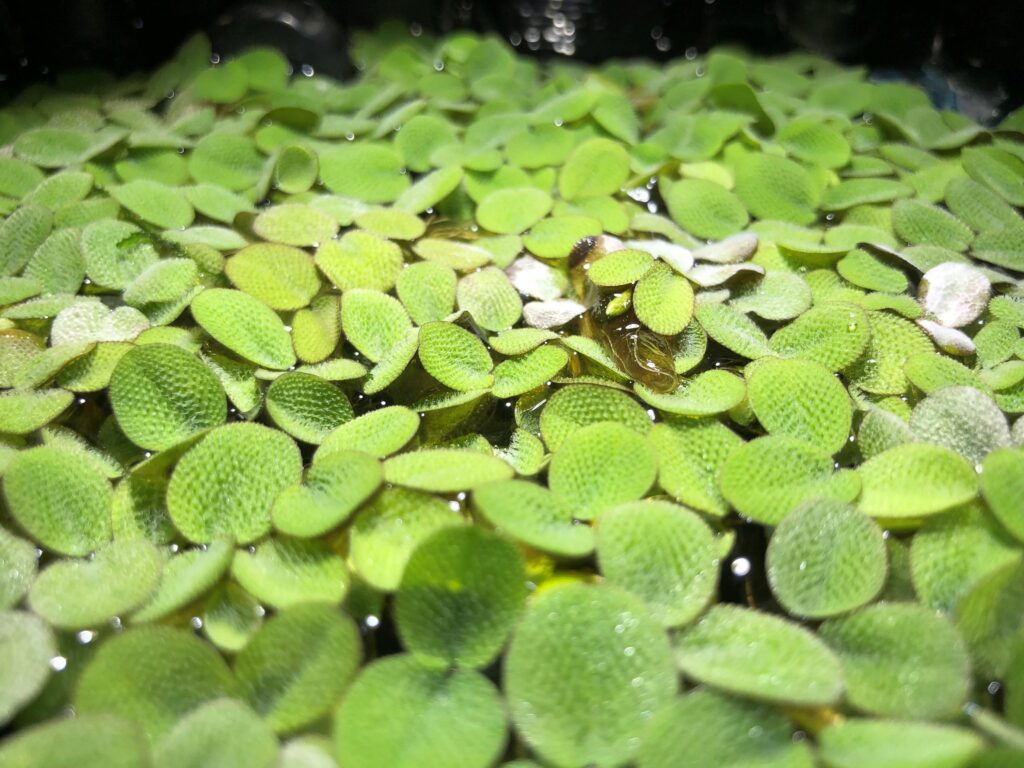
In most cases floating plants can withstand different water parameters, and salvinia is no different. This plant can develop relatively long roots, and the little white hair on the plant makes it more appealing in terms of appearance.
- Scientific name: Salvinia
- Water temperature: 16–32 °C (61–89 °F)
- Growth rate: Fast
- Lightning intensity: Low to high
- pH: 6.0 – 8.0
- Need for CO2: Low
- Fertilizer: Liquid fertilizer
- Planting: Salvinia does not need to be planted, because it is a floating plant
- Tank position: Surface
- Maximum size: 1 in / 3 cm
- Care level: Easy
- Minimum tank size: 5 gallons
In my personal experience, I accidentally got a piece of salvinia while buying other aquatic plants. In the span of 2 weeks, my whole top aquarium part was taken over by salvinia plants. These species multiply relatively quickly, so it might lead to more maintenance, but the extra effort is definitely worth it.
Amazon Frogbit
Moving on, the amazon frogbit is another floating plant, that is way different than duckweed and salvinia in appearance. Amazon frogbit has large round leaves and can look similar to water lily leaves.
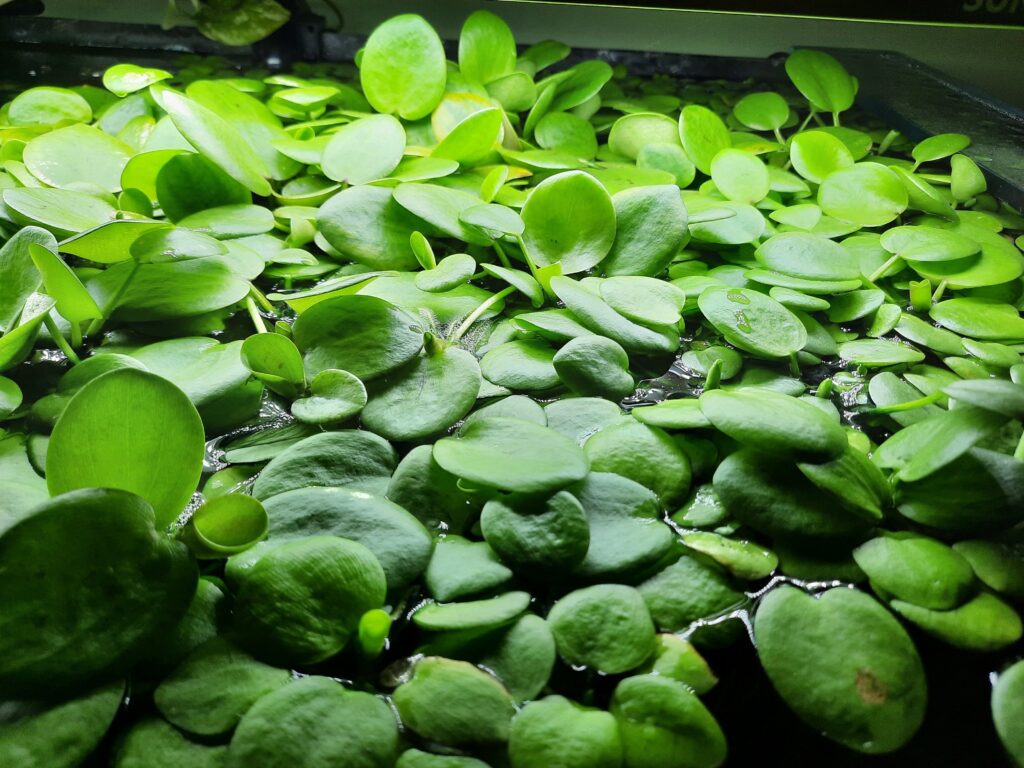
Amazon frogbit can also multiply very quickly and take over the top part of your tank. This particular plant has also the ability to flower if the conditions are good. The color of the amazon frogbit flower is white with the middle of the flower being yellow.
- Scientific name: Limnobium laevigatum
- Water temperature: 18–27 °C (64–81 °F)
- Growth rate: Fast
- Lightning intensity: Medium
- pH: 6 – 7.5
- Need for CO2: Low
- Fertilizer: Liquid fertilizer
- Planting: Does not need to be planted, because it is a floating plant
- Tank position: Upper part of the aquarium
- Maximum size: Up to 20 in / 51 cm, depending on the species
- Care level: Easy
- Minimum tank size: 5 gallons
This plant is very common in the aquarium hobby. It has been around for some time, which makes it widely available in most aquarium stores.
Hornwort
Hornwort is another column feeding aquarium plant, that can grow in multiple ways. It is different from other plants, because it has spikes instead of leaves, and can grow extremely long.
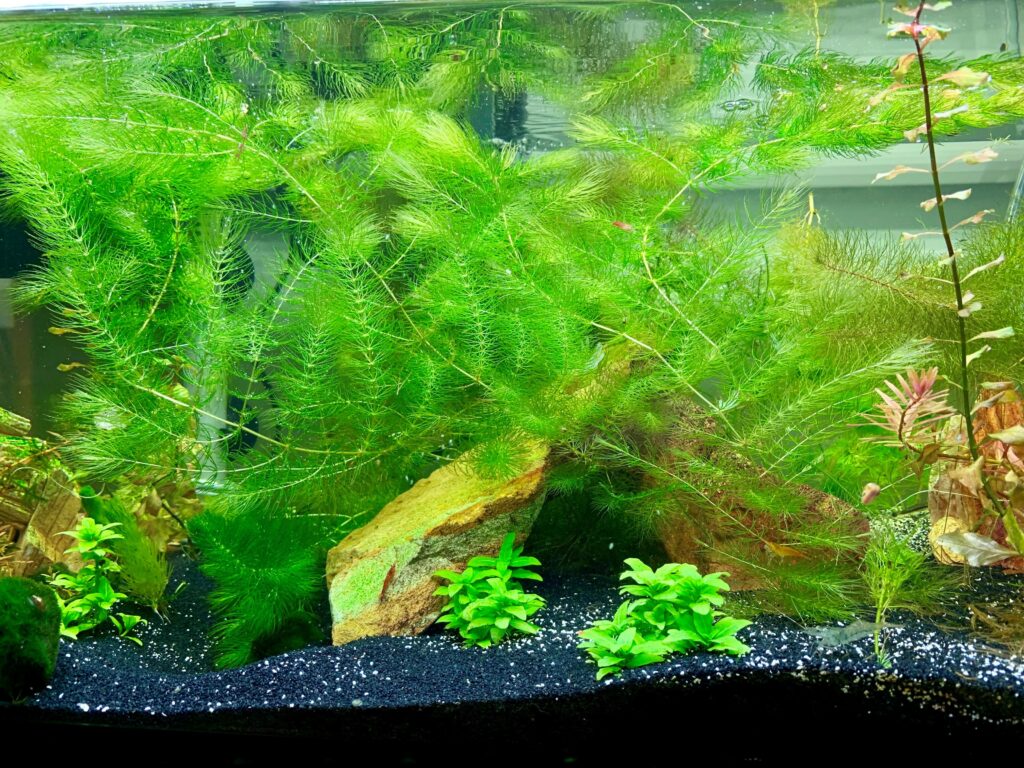
Hornwort can actually be planted in the substrate. Similar to hydrocotyle tripatita, if you decide to plant hornwort, it will start to develop roots and anchor itself in the substrate. You can also leave it floating around your tank, or attach it to something.
- Scientific name: Ceratophyllum demersum
- Water temperature: 15–30 °C (59–86 °F)
- Growth rate: Fast
- Lightning intensity: Low to high
- pH: 6.0 – 7.5
- Need for CO2: Low
- Fertilizer: Liquid fertilizer, nutrient-rich substrate
- Planting: Hornwort can be planted in the substrate. The leaves of the part that is about to be planted need to be removed, because they will rot in the substrate. It is best to use ceramic planting rings for this plant because it can easily be uprooted.
- Tank position: Midground/background
- Maximum height: 118 in / 300 cm
- Care level: Easy
- Minimum tank size: 10 gallons
One annoying thing about hornwort is the mess it can make sometimes. Hornwort can start dropping spikes if the conditions are not right, which can be very unappealing and annoying to clean. Although this rarely happens, because hornwort is not a needy plant.
Marimo Moss Ball
Moving on, the basic marimo moss ball can also be considered a column feeding aquarium plant, since it does not need to be planted to thrive. Marimo moss ball is just a ball of algae, that resembles moss in appearance, hence the name.

Marimo moss balls are very hardy plants, and can easily double in size in a short period of time. It also requires a little extra care compared to other plants, because you will sometimes need to manually flip the plant over. This needs to be done so that the bottom part of the marimo moss ball also gets some light.
- Scientific name: Aegagropila linnaei
- Water temperature: 21–29 °C (70–84 °F)
- Growth rate: Slow
- Lightning intensity: Low to medium
- pH: 7.0 – 8.0
- Need for CO2: Low
- Fertilizer: Liquid fertilizer
- Planting: Does not need to be planted, but can be attached to rocks or driftwood, or simply be placed on the substrate
- Tank position: Foreground/midground
- Maximum size: 12 in / 30 cm
- Care level: Easy
- Minimum tank size: 5 gallons
If you want to do something more with a marimo moss ball, you can attach it to decorations. Simply rip the marimo moss ball apart, and make it into a small carpet, that can be attached to a rock or other decoration of your choosing. You can use a basic string or some aquarium glue for the attachment process.
Water Weed
The last column feeding plant on this list is the American water weed. It is another versatile plant, that can either grow planted into the substrate or simply float.

Water weed is usually found in ponds or lakes, and can grow very large in terms of length. It is a perfect plant if you want to create a lot of cover for your fish and other aquatic creatures.
- Scientific name: Elodea canadensis
- Water temperature: 18–25 °C (64–77 °F)
- Growth rate: Medium
- Lightning intensity: Low to medium
- pH: 6.0 – 7.5
- Need for CO2: Low
- Fertilizer: Liquid fertilizer, nutrient-rich substrate
- Planting: Plant 2-3 inches into the substrate, or can be left floating around in the tank
- Tank position: Background/foreground
- Maximum size: 12 in / 30 cm
- Care level: Easy
- Minimum tank size: 5 gallons
Water weed is very unique in appearance since it has very small leaves, which are the greenest at the very end of the plant. Older leaves tend to become browner and can fall off easily if the water parameters are not right.
Frequently Asked Questions
Do Aquarium Plants Need Fertilizer?
Aquarium plants do need fertilizer to fully thrive. Liquid fertilizer is good for plants, which mainly absorb nutrients through leaves. Root tabs or nutrient-rich substrate is essential for species, that are heavily reliant on roots for nutrient absorption.
Can I Add Live Plants to an Established Aquarium?
Adding new plants to an established aquarium is perfectly safe and normal. There is a high chance, that the new plants will show some sort of melt (dying leaves or parts of the plant), which is perfectly normal. New plants usually cut back the new growth to save their strength and get used to new water parameters.
Writer's Thoughts
Column feeding aquarium plants can be considered one of the most durable and reliable plants in this hobby. They are highly versatile, can be kept in multiple ways, and in general do not require a lot. These plants are perfect for beginners, who do not know much about plant keeping.
If you enjoyed reading this article about column feeding aquarium plants, please feel free to share it with your friends by clicking the social media buttons below:

Thank you for reading my blog post. This website was created with the sole intention of providing quality information regarding fishkeeping. I have been in the fishkeeping hobby for 8 years, and through many trials and errors as well as online research I gathered a lot of information, which I want to give back to the community.
